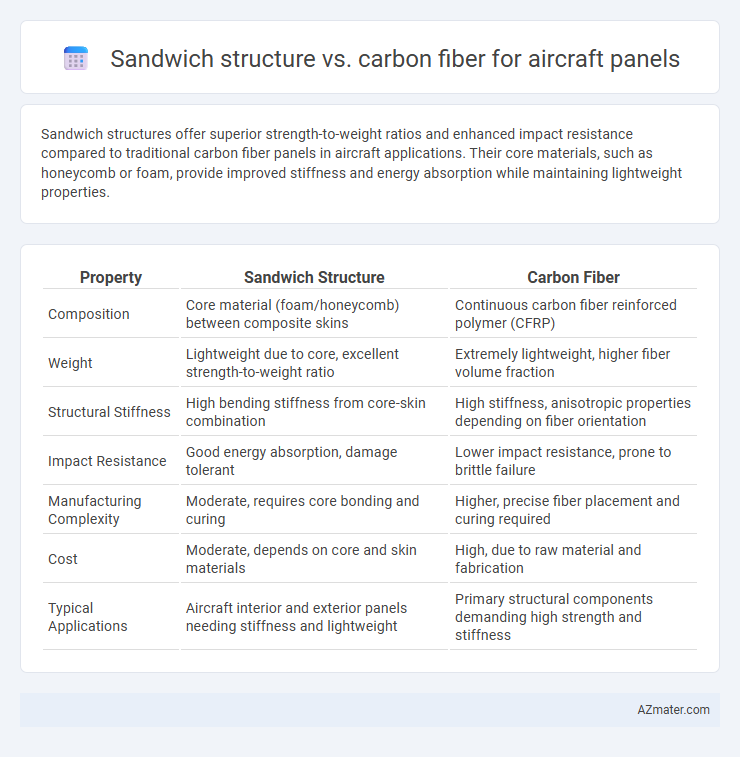Sandwich structures offer superior strength-to-weight ratios and enhanced impact resistance compared to traditional carbon fiber panels in aircraft applications. Their core materials, such as honeycomb or foam, provide improved stiffness and energy absorption while maintaining lightweight properties.
Table of Comparison
| Property | Sandwich Structure | Carbon Fiber |
|---|---|---|
| Composition | Core material (foam/honeycomb) between composite skins | Continuous carbon fiber reinforced polymer (CFRP) |
| Weight | Lightweight due to core, excellent strength-to-weight ratio | Extremely lightweight, higher fiber volume fraction |
| Structural Stiffness | High bending stiffness from core-skin combination | High stiffness, anisotropic properties depending on fiber orientation |
| Impact Resistance | Good energy absorption, damage tolerant | Lower impact resistance, prone to brittle failure |
| Manufacturing Complexity | Moderate, requires core bonding and curing | Higher, precise fiber placement and curing required |
| Cost | Moderate, depends on core and skin materials | High, due to raw material and fabrication |
| Typical Applications | Aircraft interior and exterior panels needing stiffness and lightweight | Primary structural components demanding high strength and stiffness |
Introduction to Advanced Aircraft Panel Materials
Sandwich structures combine lightweight core materials such as foam or honeycomb with strong face sheets like carbon fiber, offering high strength-to-weight ratios essential for aircraft panels. Carbon fiber composites provide superior tensile strength, stiffness, and corrosion resistance, making them ideal for performance-critical aerospace applications. Advanced aircraft panels leverage these materials to enhance durability, reduce weight, and improve fuel efficiency in modern aviation.
Overview of Sandwich Structure Technology
Sandwich structure technology in aircraft panels consists of two thin, strong face sheets bonded to a lightweight, thick core, providing exceptional strength-to-weight ratios and enhanced stiffness. Common core materials include aluminum honeycomb, Nomex, or foam, which contribute to energy absorption and impact resistance while reducing overall weight compared to solid carbon fiber panels. This structural design optimizes mechanical performance and thermal insulation, making sandwich panels ideal for high-performance aerospace applications where weight savings and durability are critical.
Key Properties of Carbon Fiber Panels
Carbon fiber panels for aircraft exhibit exceptional strength-to-weight ratios, with tensile strengths often exceeding 500 MPa and densities around 1.6 g/cm3, significantly enhancing fuel efficiency and structural performance. These panels offer superior stiffness and fatigue resistance compared to traditional sandwich structures, enabling longer service life and reduced maintenance costs. Advanced carbon fiber composites also provide excellent impact resistance and thermal stability, crucial for maintaining integrity under varying flight conditions.
Weight Comparisons: Sandwich Structure vs Carbon Fiber
Sandwich structures typically offer superior weight efficiency compared to solid carbon fiber panels due to their lightweight core materials like honeycomb or foam, significantly reducing overall panel weight while maintaining strength. Carbon fiber panels, although strong and stiff, are denser and heavier, which can increase aircraft weight and impact fuel efficiency. In aerospace applications, sandwich structures optimize weight savings by combining thin carbon fiber skins with lightweight cores, achieving a better strength-to-weight ratio than solid carbon fiber alone.
Structural Strength and Stiffness Analysis
Sandwich structures, composed of lightweight core materials like honeycomb or foam bonded between composite face sheets, offer superior stiffness-to-weight ratios compared to traditional carbon fiber panels, making them ideal for aircraft panel applications. Carbon fiber panels provide high tensile strength and excellent fatigue resistance but generally lack the enhanced out-of-plane stiffness and damage tolerance found in sandwich composites. Structural strength and stiffness analysis reveals that sandwich panels reduce bending deformation and improve load distribution, resulting in optimized performance and weight savings critical for aerospace structures.
Durability and Fatigue Resistance in Aerospace Applications
Sandwich structures offer excellent fatigue resistance due to their multi-layer construction, effectively distributing stress and reducing crack propagation in aerospace panels. Carbon fiber composites provide superior durability with high strength-to-weight ratios, but may be more susceptible to impact damage and require careful inspection for fatigue-induced delamination. In aerospace applications, combining sandwich design with carbon fiber skins enhances panel longevity by leveraging both materials' strengths in durability and fatigue resistance.
Cost Implications for Manufacturing and Maintenance
Sandwich structures typically offer lower manufacturing costs compared to carbon fiber panels due to simpler fabrication processes and the use of less expensive core materials like foam or honeycomb. Carbon fiber panels, while more costly initially because of advanced composite materials and labor-intensive production, provide superior strength-to-weight ratios and durability, potentially reducing long-term maintenance expenses. Evaluating total cost of ownership requires balancing upfront manufacturing expenses against anticipated maintenance savings and lifecycle performance in aerospace applications.
Thermal and Environmental Performance
Sandwich structures in aircraft panels offer superior thermal insulation due to their core materials like honeycomb or foam, effectively reducing heat transfer compared to solid carbon fiber panels. Carbon fiber panels provide excellent environmental resistance, including high strength-to-weight ratio and corrosion resistance, but tend to conduct heat more readily, impacting thermal performance. The choice between sandwich structures and carbon fiber hinges on balancing thermal insulation requirements with environmental durability in aviation applications.
Typical Use Cases in Modern Aircraft Design
Sandwich structures are widely used in aircraft panels for their exceptional strength-to-weight ratio and excellent impact resistance, making them ideal for interior flooring, fairings, and control surfaces. Carbon fiber panels dominate in areas demanding superior stiffness and high fatigue resistance, such as primary structural components and external skins. Modern aircraft design often combines both materials to optimize weight savings, durability, and aerodynamic performance.
Future Trends in Aircraft Panel Material Innovations
Future trends in aircraft panel material innovations emphasize hybrid sandwich structures integrating advanced carbon fiber composites to enhance strength-to-weight ratios and thermal resistance. Development of multifunctional panels with embedded sensors and self-healing capabilities is accelerating, leveraging nanomaterials within carbon fiber layers to improve durability and maintenance efficiency. Sustainable manufacturing processes using recycled carbon fiber and bio-based resins are also gaining traction to meet environmental regulations and reduce lifecycle carbon footprints.

Infographic: Sandwich structure vs Carbon fiber for Aircraft panel
 azmater.com
azmater.com